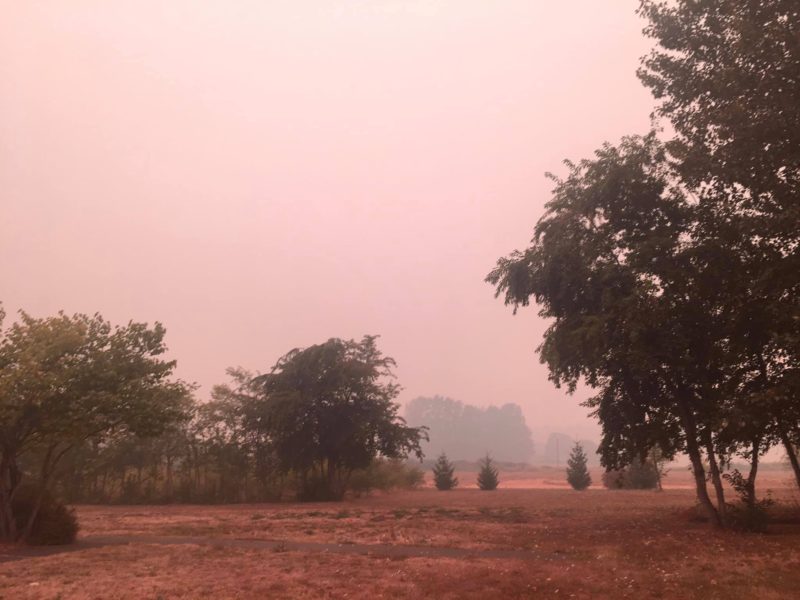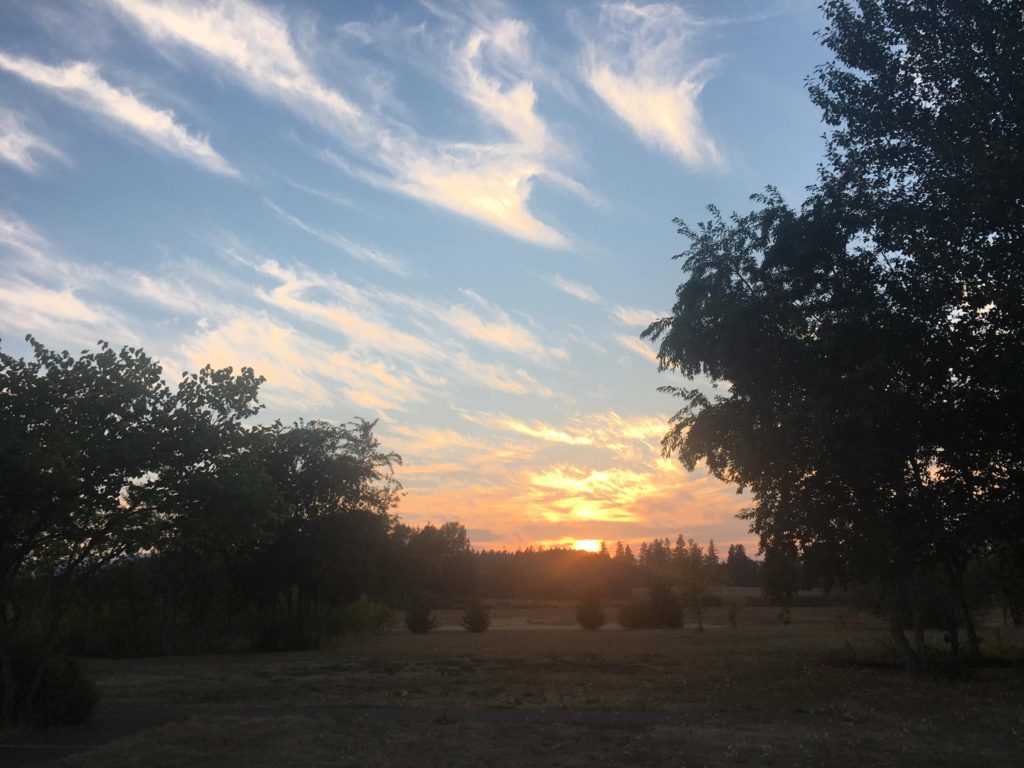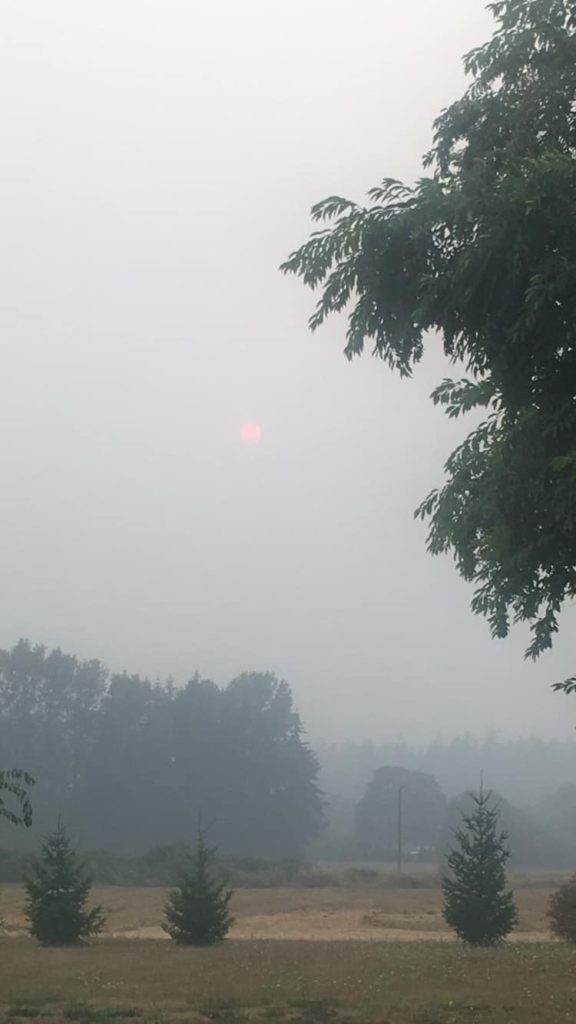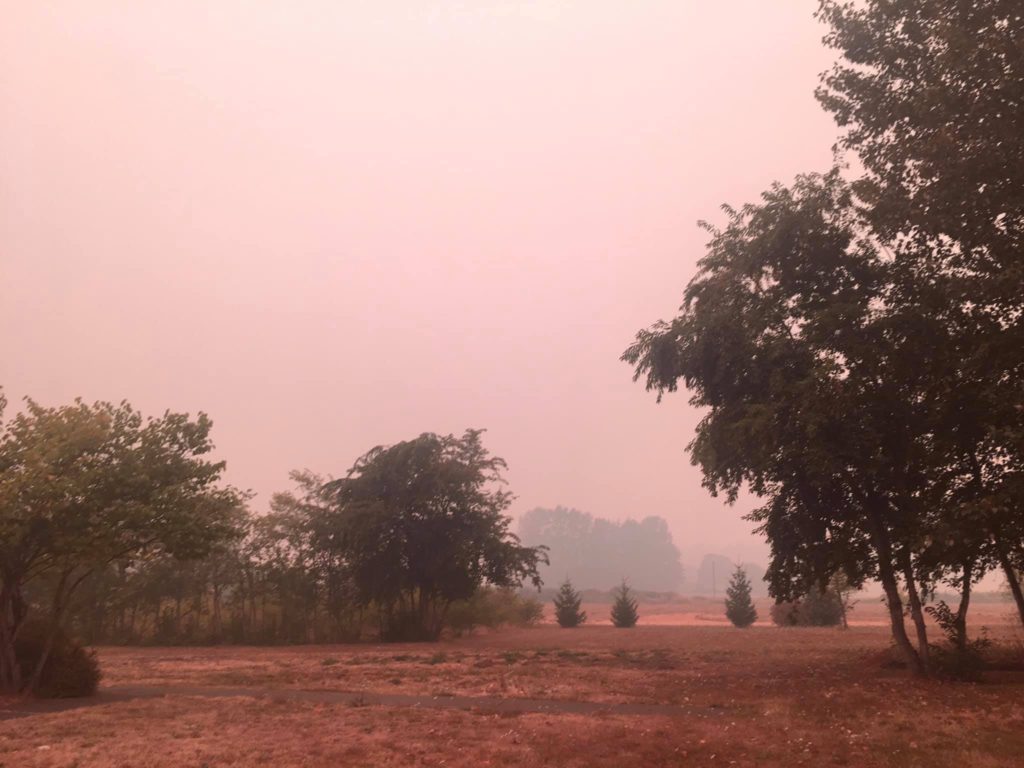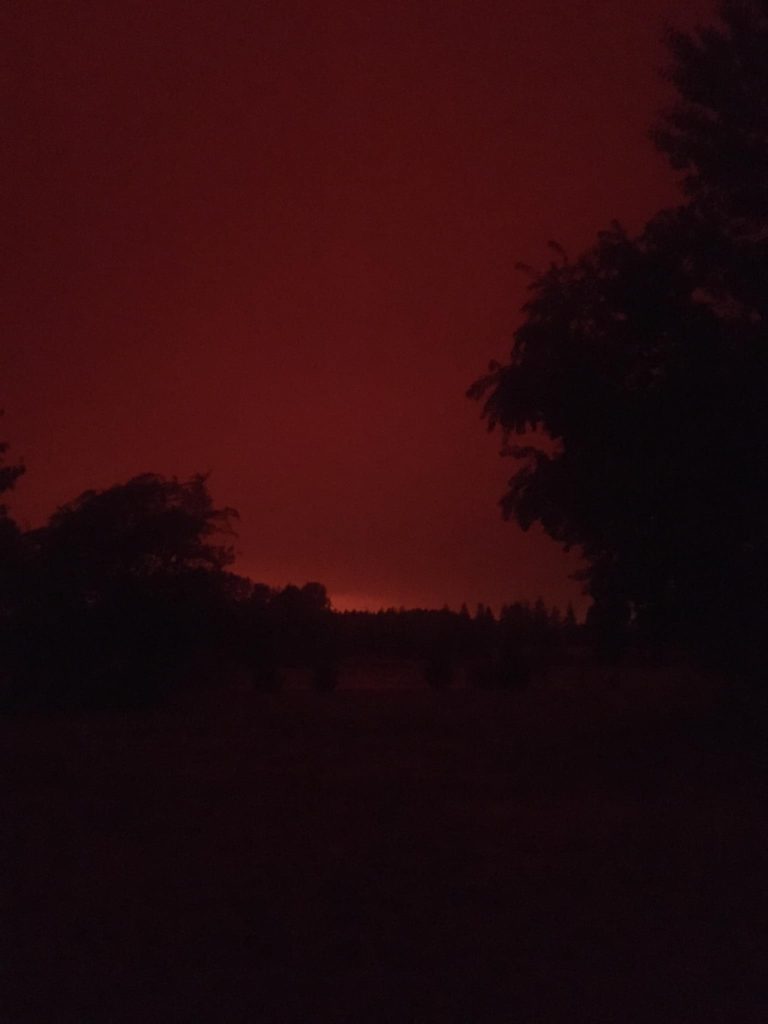Disappearing Sun
It’s Friday morning. Hard to believe this only started over dinner Monday. Sat outside, we realized it was becoming harder to see the far-side of the recently harvest bean field just below our caravan. Then the smell came. The burnt campfire smell of Guy Fawkes night; so strong that Alan drove a little north assuming the fire’s origin must be in a part of our small state park that we can’t immediately see from our site. The fire had to be close.
But no, at that point the nearest flames were over 40 miles away. Consuming timber, businesses, homes at such a rate that the smoke filled the low lying Willamette Valley where we’re based; driven hard by easterly winds. Finding tinderbox conditions the flames run amok.
Oregon is reputed to be wet and rainy. In this western half, flanked by the Pacific on one side and Cascade Mountains on the other, it is, but only in the winter months. West Oregon summers are Mediterranean warm, with gorgeous days and cool-enough nights. We won’t see much rain until November.
The far east of the state with its high deserts and arid scrub, suffers far more wildfires than the lush west. Over here are temperate forests and rich farm land, sitting alongside the manic interstate corridor that is the I-5.
By Monday evening it was clear we’ were seeing major effects. The beautiful sunsets of past days gave way to a sick orange Sun, trying in vain to make a mark. By Tuesday morning we were in a different world. Sunrise was 6:44am; except there was no Sun. A strange morphed red twilight engulfed us, omnipresent and portent. In the intervening days the air has become thick, a strange tangible charred presence swirling around us. For those of us fortunate enough that the worst events of the week have centered around this broth-like air quality – that alone has been debilitating. Throughout the covid struggles, outside has been a refuge, one of very few places where one has the potential to feel safe, and this week that solace has gone too.
Resources are so stretched that 150,000+ acre fires are being fought by 200 firefighters. Mother-nature has to turn this around.
We’re feeling inept and unprepared, but are trying to bolster the spirits of friends who’ve possibly lost every single thing from the meaningful to the trivial. Everything. What do you say? The waiting and unknown. Communities are gone, and the strength you gain from neighbors with it. And some of those neighbors may not have made it through.
The sick orange pallor of the sky seems such an apt metaphor for how the whole west coast is feeling.
Bates State Park
We are volunteering at Bates State Park. Amongst Oregon’s newest state parks, it is in that awkward ‘tweenies’ stage, not young enough to be novel, not established enough to be on visit lists. We love it!
Bates was a lumber town. Positioned to make astute use of the railway system, a thriving mill town developed – multiple holding ponds for the felled timber, a kiln for drying; and housing, infirmary and school for the workers and their families. That was until 1975 when the mill shut. The mill owner sold on the houses for $1, and the residents that could (and most could) literally picked up their homes and moved to other nearby communities. Obviously the Bates community schismed, but has remained connected through reunions and events. Central to that effort, was the creation of Bates State Park.
Very little of the physical community remains, really just the upper pond, trapped by its imposing stone damn. The site of the foreman’s house, on a pretty knoll, is now the hiker/cyclist camping area and the lower pond has filled in and been reclaimed as the main RV campground. The infirmary, school and associated residencies have been lost back to the woodland and a meadow now fills the area formally full of workers homes. Paths wind in the trees above the pond, and along the brook, and there are salmon coming upstream to spawn.
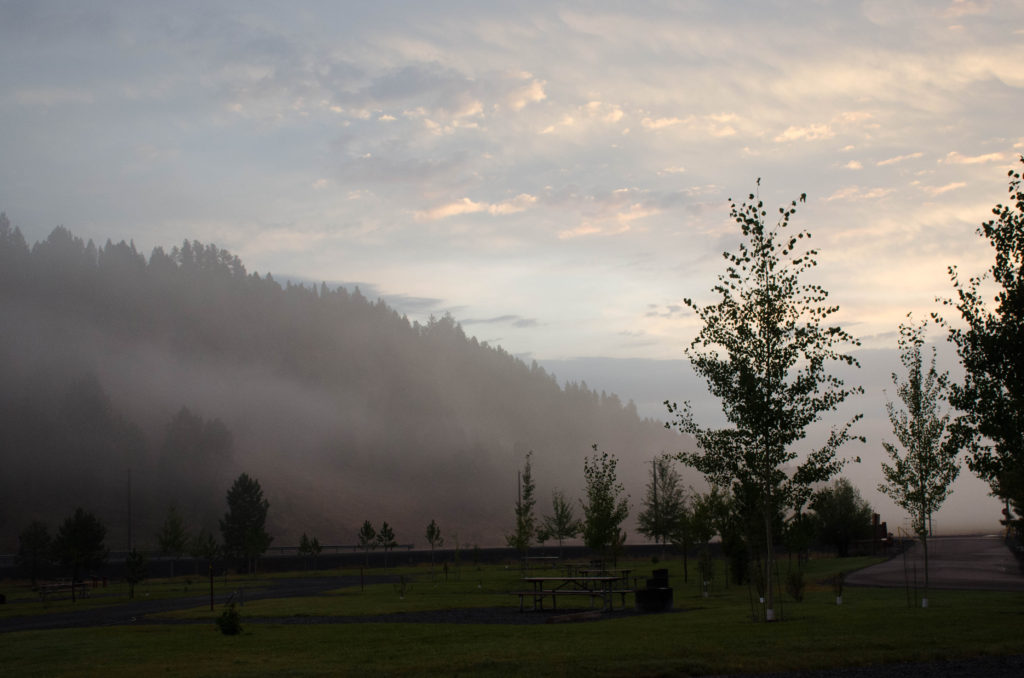
A Continental Divide
We’ve been zigzagging across the continental divide for the last week or so. The divide highlights the point at which the Atlantic watershed changes to that of the Pacific. Rain drops falling just a few inches apart will have a very different ultimate destination.
We’re leaving behind the world of the Hudson, St. Lawrence, Missouri and Mississippi and moving into the sphere of Columbia, Snake and Stikone.
The imaginary line has felt very symbolic. This way for the familiar, hither for the new.
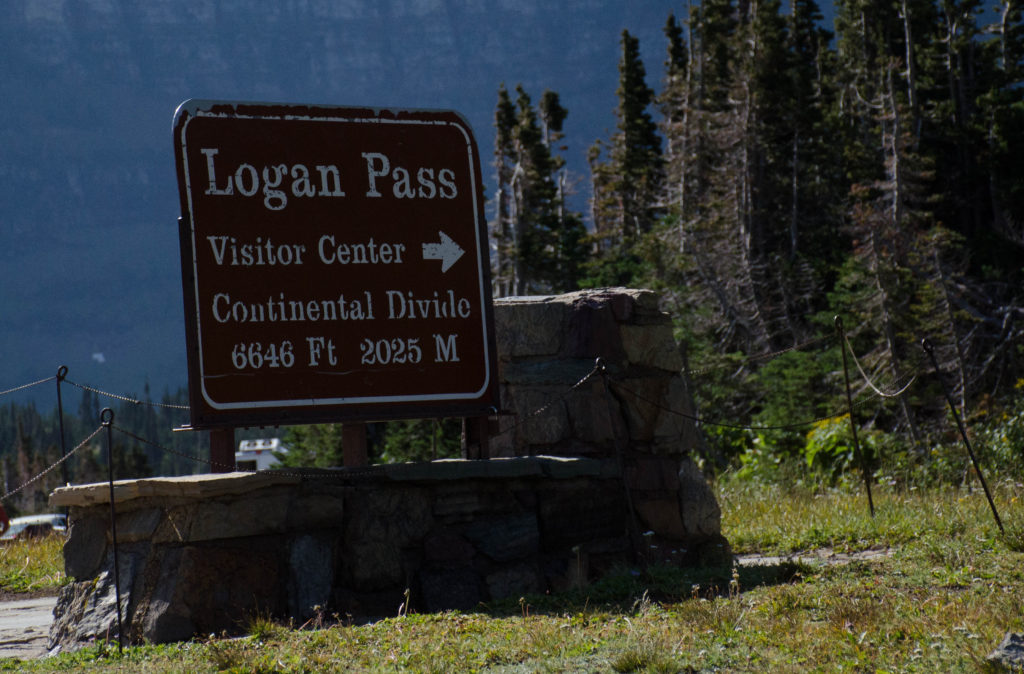
A Tale of Two Towns
We’ve recently visited Deadwood (yes the one in the movies and, apparently, an HBO series) and Cody. Both played their own key roles in the development, and continuation, of ‘The West’.
Deadwood was the site of the last real
US gold rush, a century and a half ago. A truly wild place it drew the desperate prospector. The town was more saloons and gambling houses than service hub. As the community grew a degree of order was established by the likes of Wild Bill Hickock and Calamity Jane.
Over time of course the prospectors moved on, the town dwindled and sunk towards a ghost of its former self.
About 50 years ago the remaining residents applied for a special ordinance to allow gambling (a tightly controlled state based decision) back to the town.
The result is a strange 21st century take on the ‘wild west’ with the Main Street again brimming over with bars and gambling rooms. The town draws folks looking for the strange excess you feel on Bourbon St in New Orleans, jumping the bars in Key West or walking the strip in Vegas. As before the town has no clear purpose beyond its hedonistic draw. Despite this, you can’t help admiring the pioneers in both the birth and rebirth of Deadwood who kept the town alive.
In contrast Cody’s historic draw is its namesake Buffalo Bill Cody. The ultimate cowboy showman, Buffalo Bill toured the world at the turn of the 19th and 20th centuries providing entertainment somewhere between a vaudeville show, an old fashioned circus and a rodeo. His role in popularizing the image of the show off, quick draw cowboy can’t be underestimated.
The town has developed its place in today’s tourist market through rodeo shows and a group of museums covering everything from natural history to revolvers. Building the then largest dam in the world just west of Cody straight after WW1 didn’t hurt either, nor its place as the first decent sized community east of Yellowstone.
The two towns have provided an interesting contrast of how to redefine and succeed as communities through two very different, but connected, ways.
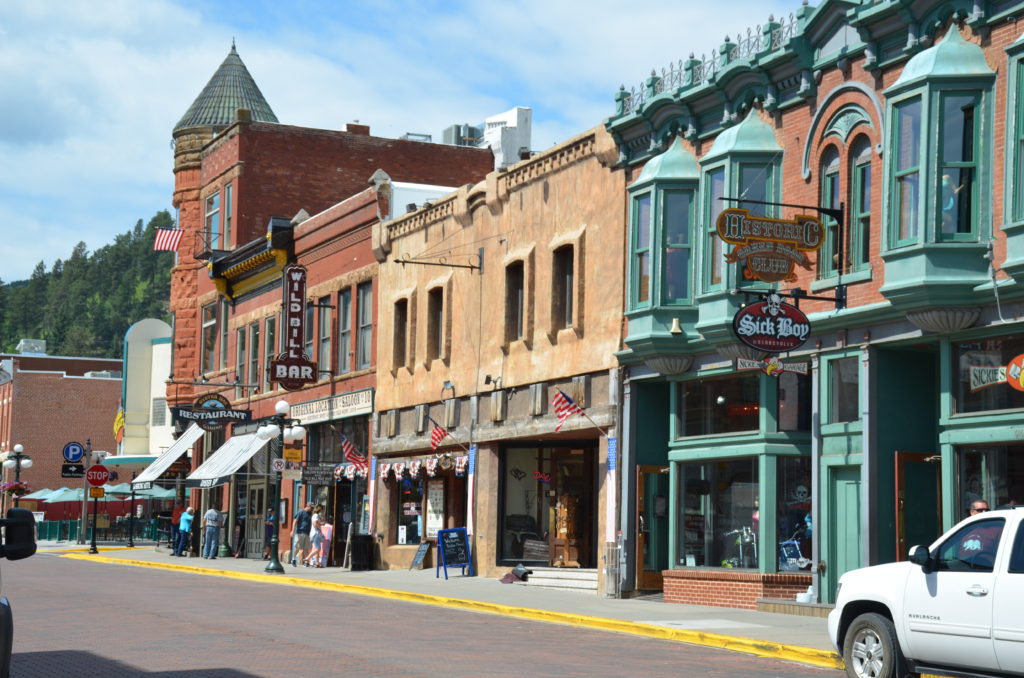
Wyoming Rights
I think there’s a temptation to think of the historic west as lawless, full of macho testosterone and maverick gunslingers. Whist elements of that picture are undoubtedly true, there was also a deal of male / female equality that was ahead of much of 19th century norms.
For example, here in Wyoming, women were given the vote in 1869, more than twenty years before the territory even became a state; becoming the first to provide that right in the US. They also elected the first female governor in 1924. The state’s motto is ‘Equal Rights’.
As with other American states though, race or sexual equality has been a slower road sadly.
Off the grid
Last week we were staying in a Forestry Services campsite, Tucked deep in the Black Hill of western South Dakota, there is no cell service. That’s lovely until your dog needs a vet.
Cue South Dakota hospitality. Lots of brain racking from our camping neighbors on how to find info. Bingo- the ‘local’ general store has a landline. Off Alan goes to investigate, explanations follow and then the whole store’s working in the issue. Phone calls down to Custer, others north to Rapid City bear fruit. Off we all trot to the vets. (Dogs fine.). Promised return visit to store fulfilled, beers all round, visits from campers to check in the (perfectly fine) patient. Amidst the worry and hassle, was a great lesson in priorities.
The Great Hyperion Plains
We set out tomorrow on what we’re referring to as ‘The Crossing’. Four days from Michigan to South Dakota via Wisconsin and Minnesota.
The reference (for non sci-fi geeks) is to a classic book by Dan Simmons, Hyperion and the Sea of Grass. Simmons describes huge plains with uniform grass, so coarse that you can sail across the surface in windwagons.
My image is skewed of course as we don’t meet the Great Plains until South Dakota, but somehow I’m visualizing great banks of corn, one can glide over like a racing clipper in the North Atlantic.
Sadly we’ll be driving interstates 41 and 90 instead.
The River That Flows Two Ways
Our first travel day took us barely (but significantly) outside Massachusetts, landing at the Shodack Island State Park, on the Hudson River, just south of Albany, New York.
The first sizeable river of the journey, I think big rivers might become a theme.
The Mohican’s called the Hudson the Muhheakantuck ‘The River That Flows Two Ways’. Even at Albany the river is tidal and gently sloshes upstream with the incoming tide. The flow is so slow and languid that a stick thrown in the river here will wash back and forth in unhurried oscillations, eventually traveling the 120 or so miles to the Atlantic in around 4 months. I hope your travels take on a similar tempo.
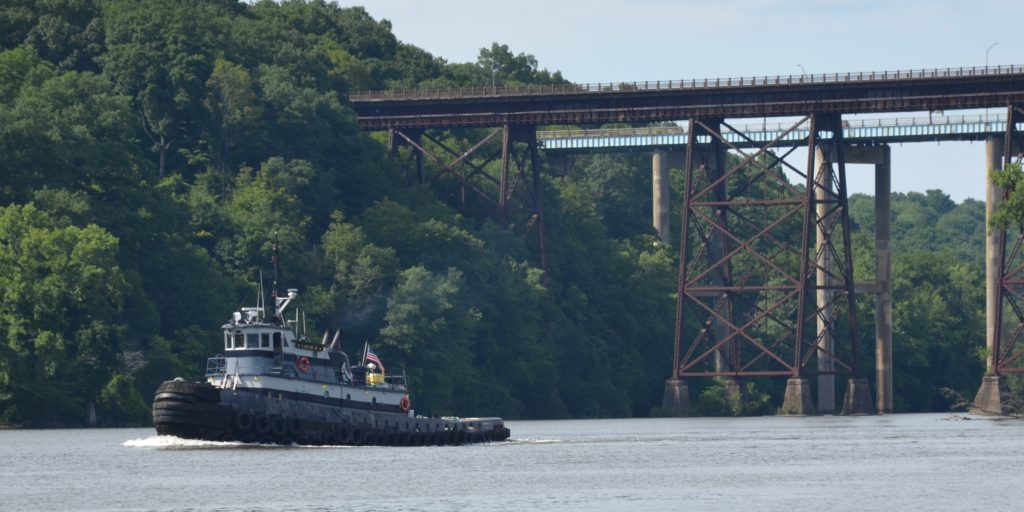
Launch Day minus 1
We plan to roll west from Massachusetts tomorrow. There are bound to be a myriad of things we’ve not packed, As much again that we have with us which will be ultimately be redundant I suspect.
It’s been a strange few weeks of farewells and ‘bon voyage’ but without the bite of when we left Wales. If you cross a continent, rather than an ocean, does it feel less dramatic? If you leave a ‘new home’ rather than ‘true home’ is it less of a wrench?
